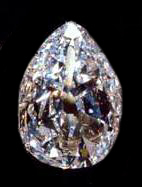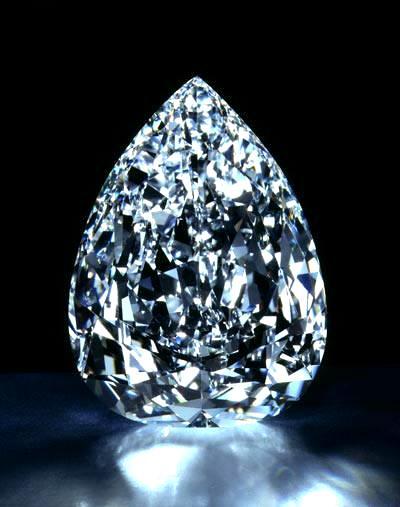




Looking After Your Finds - Reference

Powered By Sispro1
Designed by Nigel G Wilcox
Famous Diamonds



Excelsior diamond
June 30, 1893 appeared to be just another day at the Jagersfontein Mine in South Africa until a worker, performing the mundane task of shoveling dirt into a truck, made the startling discovery of a rough, magnificent looking diamond. Fearing that reporting his find to his ethically challenged overseer could cost him credit for the discovery, the worker wisely took the stone directly to the mine manager, thus ensuring himself credit for the discovery and the handsome reward that went with it. In this case that reward consisted of a horse, bridle, and saddle.
eighing in at a whopping 995.2 carats, blue-white in color and of fine quality, this magnificent gem claimed the status of largest diamond known in the world, surpassing all of the historic diamond discoveries in India, a record that country had proudly held for five centuries. Because of its loaf of bread or mountain shape, flat on the bottom rising to a peak, the impressive gem was named Excelsior which means ever higher .
By 1903, the Excelsior had made its way to London. With its intimidating size no doubt scaring off potential buyers, the crystal was finally sent off to Asscher of Amsterdam for cutting. Upon closer examination of the diamond, Asscher discovered the disappointing fact that the Excelsior diamond contained a number of small dark inclusions. These inclusions made any hope of cutting a record setting gem impossible and created a real challenge for Asscher. After a thorough study was conducted, Asscher decided to cleave the massive diamond into ten pieces, resulting in the largest stone from the cut (labeled the Excelsior I) weighing only 69.68 carats. The remainder of the Excelsior was cut into a total of twenty large polished gems with ten of them over 10 carats - ranging from approximately 47 carats to less than 1 carat. Of the original 995.2 carats, 373.75 carats of gem quality material was created. Considering the obstacles presented by the nature of the Excelsior diamond in its rough form, the results of the cutting were beyond all expectations, a real tribute to the Royal Asscher Diamond Company s craftsmanship.
June 30, 1893 appeared to be just another day at the Jagersfontein Mine in South Africa until a worker, performing the mundane task of shoveling dirt into a truck, made the startling discovery of a rough, magnificent looking diamond. Fearing that reporting his find to his ethically challenged overseer could cost him credit for the discovery, the worker wisely took the stone directly to the mine manager, thus ensuring himself credit for the discovery and the handsome reward that went with it. In this case that reward consisted of a horse, bridle, and saddle.
eighing in at a whopping 995.2 carats, blue-white in color and of fine quality, this magnificent gem claimed the status of largest diamond known in the world, surpassing all of the historic diamond discoveries in India, a record that country had proudly held for five centuries. Because of its loaf of bread or mountain shape, flat on the bottom rising to a peak, the impressive gem was named Excelsior which means ever higher .
By 1903, the Excelsior had made its way to London. With its intimidating size no doubt scaring off potential buyers, the crystal was finally sent off to Asscher of Amsterdam for cutting. Upon closer examination of the diamond, Asscher discovered the disappointing fact that the Excelsior diamond contained a number of small dark inclusions. These inclusions made any hope of cutting a record setting gem impossible and created a real challenge for Asscher. After a thorough study was conducted, Asscher decided to cleave the massive diamond into ten pieces, resulting in the largest stone from the cut (labeled the Excelsior I) weighing only 69.68 carats. The remainder of the Excelsior was cut into a total of twenty large polished gems with ten of them over 10 carats - ranging from approximately 47 carats to less than 1 carat. Of the original 995.2 carats, 373.75 carats of gem quality material was created. Considering the obstacles presented by the nature of the Excelsior diamond in its rough form, the results of the cutting were beyond all expectations, a real tribute to the Royal Asscher Diamond Company s craftsmanship.
The Millennium Star Diamond
The Millennium Star Diamond
The Millennium Star Diamond
In 1990 the diamond was discovered in the Mbuji-Mayi district of Zaire (Republic of the Congo) in alluvial deposits and was purchased by De Beers. The cutters of the Steinmetz Diamonds Group took over three years to complete the classic pear form with 54 facets. Some 100 plastic models of the original rough were made, and these were almost all used to plan and design the optimum polished stone in beauty and weight. The cutting was done using lasers. The Millennium Star is a pear-shaped diamond weighing 204,04 carats. It is the world?s second largest diamond in the top colour-grade D, internally and externally flawless, cut to perfect proportions. The rough diamond was weighing the magic number of 777 carats. The first is the 273.15 carat Centenary Diamond. The first display to public was in October 1999 as the centerpiece of the De Beers Millennium Diamond Collection? in London. A second exhibition was the De Beers Millennium Jewels Exhibition? at the new Millennium Dome in London in 2000. There was an attempt to steal the diamond from the exhibition hall by using bulldozers to break in but the attempt was thwarted by a tip to Scotland Yard.
In 1990 the diamond was discovered in the Mbuji-Mayi district of Zaire (Republic of the Congo) in alluvial deposits and was purchased by De Beers. The cutters of the Steinmetz Diamonds Group took over three years to complete the classic pear form with 54 facets. Some 100 plastic models of the original rough were made, and these were almost all used to plan and design the optimum polished stone in beauty and weight. The cutting was done using lasers. The Millennium Star is a pear-shaped diamond weighing 204,04 carats. It is the world?s second largest diamond in the top colour-grade D, internally and externally flawless, cut to perfect proportions. The rough diamond was weighing the magic number of 777 carats. The first is the 273.15 carat Centenary Diamond. The first display to public was in October 1999 as the centerpiece of the De Beers Millennium Diamond Collection? in London. A second exhibition was the De Beers Millennium Jewels Exhibition? at the new Millennium Dome in London in 2000. There was an attempt to steal the diamond from the exhibition hall by using bulldozers to break in but the attempt was thwarted by a tip to Scotland Yard.
Note: There are more famous diamonds within public view and owned behind closed doors by private collectors
Copyright All Rights Reserved by Nigel G Wilcox E-Mail: ngwilcox100@gmail.com
Rocks & Minerals Menu
Complimentary Topics
The Paragon Of Metal Detecting
& Archaeology
& Archaeology
Who Owns the World's Gold?
Pages
Member NCMD
Reference Menu
Group Pages
[1]
[2]
[3]
[4]
[5]
[6]
[7]
[8]
Famous Diamonds




















